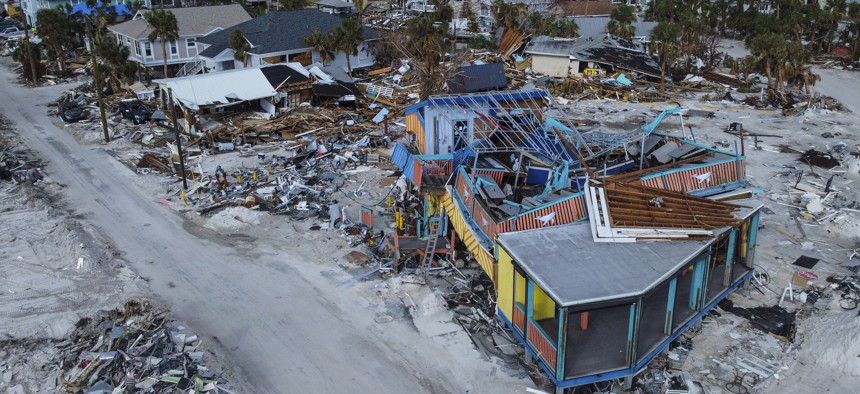After Ian: Five Questions for CFO Jimmy Patronis on electric vehicle fires
‘The only solution out there (is) just put a fire hose on it and let the fire hose run,’ he says.

Fort Myers Beach was ground zero for storm surge as the area was completely submerged when the hurricane struck. Photo by Thomas O'Neill/NurPhoto via Getty Images
Aside from the disruption and destruction wrought by Hurricane Ian, the storm highlighted a uniquely 21st century problem: flooded electric vehicles exploding into flames. More precisely, the salt water corrodes the lithium-ion batteries of EVs and they ignite. And if a vehicle is inside a flooded garage attached to a home, it’s a disaster waiting to happen, Florida Chief Financial Officer Jimmy Patronis tells City & State.
Here’s the problem, as Ed Angelotti – district chief of special operations for the Orlando Fire Department – explained to WFTV: “A normal car fire we could put out with 500 to 700 gallons. These types of fires are taking … anywhere from 20,000 to 40,000 gallons of water.”
Related story: After Ian – Why many fire departments aren’t ready for electric vehicles
Patronis, who is also the state fire marshal, saw the problem firsthand when he was in southwest Florida after Ian. Here are five questions for Patronis, including what firefighters can do to better combat these blazes (spoiler: not much). Questions and answers are edited for clarity and brevity.
Can you tell us your experience with these electric vehicles after the storm?
Just days after Hurricane Ian, we were with North Collier Fire District and touring the damage there in Collier County. We stop at a house in a neighborhood … and as we're standing in front of one of these houses, there's a blue EV parked in the garage. And the battalion chief says, “We gotta get that vehicle out of there.” You could see where the flood waters were, you could see the humidity building up inside the windshield as this car had obvious flood damage. So we're trying to find the owner. Later, we were actually the first on the scene of an EV that was on fire … on a flatbed. The operator wisely dumped it off (and) two fire engines show up. They used both of their supply tanks, 750 gallons a piece on this EV. Made zero dent into that fire.
How did they get it under control?
You know, once they put several thousand gallons of water on the EV, it got to the point where they could drag it off to the side of the road. The firefighters did what they could do in this particular situation – the only solution out there, which to me is 100% unacceptable – just put a fire hose on it and let the fire hose run. Then somebody has to babysit this EV to make sure that it does not catch fire again and cause harm to anyone else. Well, this particular EV, after we left it that afternoon, about six hours later it reignited. Members of that fire department told me it was the fourth EV fire that they responded to that week.
How many EV blazes were eventually reported?
We’ve got eight documented that we know of. I know that there’s a potential for more, as you've heard about the golf carts, even motorized bicycles, anything that's got a lithium-ion battery. We reached out to NHTSA (National Highway Traffic Safety Administration) and asked them some difficult questions and they came back with some very difficult answers. And some of our fears were realized by their answers, that salt water is an incredible conductor. And as these batteries get shorted, their temperatures will rise and they can burn and self-ignite. And once it ignites, the only thing you can do is just dump water on it. … There are over 7,000 EVs in the affected area. We know there's been over 160 so far that have had some form of an insurance claim. And these cars then get sold and shipped all over the United States based on their drivability. So now these things are literally a ticking time bomb, possibly going to another part of the country.
Did your team record what was happening?
Oh yeah. It'll blow your mind. We had all our drone groups down there also. So I went ahead and told our drone people, "Go fly over them" (referring to dealership lots). You see cars as far as the eye can see, and I mean, and they're packed like sardines. And then you see a different photo where the Teslas are all parked. They're literally a football field away because … if one combusts, that will destroy the entire inventory.
Is anybody working on a fix better than pouring thousands of gallons of water on EV fires?
Not that I know of. I mean, I think there's some room in trying to create some solutions. But there's not a single manufacturer that wants to acknowledge that there's a salt water flooding problem. I tell these guys, "Look, Mother Nature just educated us to a problem that we have to deal with." But nobody, I mean, nobody wants to say, "Jimmy, you're right. We've got to come up with a flooding solution because EVs aren’t going away." I'm definitely looking for help. Look, this shouldn't be something we require legislation to do. These manufacturers should be leaning forward and coming up with solutions. I just think they're very fearful of the liability and litigation that may come with them admitting anything.
Contact Jim Rosica at jrosica@cityandstatefl.com and follow him on Twitter: @JimRosicaFL.
NEXT STORY: The five big voter registration takeaways from Florida
